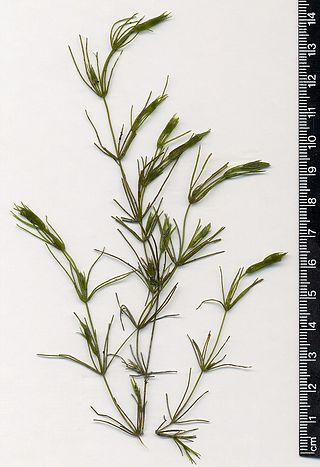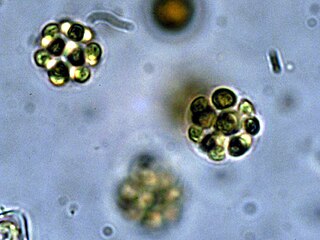
Charales is an order of freshwater green algae in the division Charophyta, class Charophyceae, commonly known as stoneworts. Depending on the treatment of the genus Nitellopsis, living (extant) species are placed into either one family (Characeae) or two. Further families are used for fossil members of the order. Linnaeus established the genus Chara in 1753.

Lyngbya is a genus of cyanobacteria, unicellular autotrophs that form the basis of the oceanic food chain.
Chlorococcales is a formerly recognized order of green algae in the class Chlorophyceae. As of February 2022, the type family Chlorococcaceae was placed in the order Chlamydomonadales.
Oocystaceae is a family of green algae, in the order Chlorellales. The type genus is Oocystis.

Botryococcus is a genus of green algae. The cells form an irregularly shaped aggregate. Thin filaments connect the cells. The cell body is ovoid, 6 to 10 μm long, and 3 to 6 μm wide. Fossils of the genus are known since Precambrian times, and form the single largest biological contributor to crude oil, and are a major component of oil shales.

Golenkinia is a genus of green algae first described in 1894 by Robert Chodat. The genus is named for the Russian phycologist Mikhail Iljitsch Golenkin. Golenkinia species live in fresh water and are found around the world.

Kirchneriella is a genus of green algae in the family Selenastraceae. It is found in freshwater habitats, as phytoplankton or metaphyton.

Schroederia is a genus of green algae in the family Schroederiaceae. Schroederiaceae is a monotypic taxon; Schroederia is its only genus.

Stauridium is a genus of green algae in the family Hydrodictyaceae. It is very common in freshwater regions throughout the world.
Actinochloridaceae is a family of green algae, in the order Chlamydomonadales.

Characiaceae is a family of green algae in the order Sphaeropleales. It contains epiphytic or planktonic algae that are unicellular or colonial. The cells are heteropolar, with basal and apical ends having different shapes. The daughter cells are often retained in the cell wall of the old mother cell, whose cell wall becomes gelatinized.

Actidesmium is a small genus of green algae in the family Characiaceae. It was described by the German phycologist Paul Friedrich Reinsch in 1875.
Deuterocharacium is a genus of green algae in the family Characiaceae. It is found in freshwater habitats, attached to algae or detritus. It is rare and has only been recorded from Europe.
Chlorotetraedron is a genus of green algae, in the family Neochloridaceae. The name may also be written as Chlorotetraëdon. It is found as freshwater plankton or in soil.
Poloidion is a genus of green algae in the family Neochloridaceae, containing the single species Poloidion didymos. It is an extremely rare genus, which has only been recorded once on moist soil and rocks in Austria.
Sykidion is a genus of green algae. Pseudoneochloris is a synonym of this genus. As of March 2022, Sykidion was the only genus in the family Sykidiacaeae, which was the only family in the order Sykidiales.

The Rivulariaceae are a family of cyanobacteria within the Nostocales in which the filaments (trichomes) are tapered from wider at the base to narrower at the tip.

Scytonema is a genus of photosynthetic cyanobacteria that contains over 100 species. It grows in filaments that form dark mats. Many species are aquatic and are either free-floating or grow attached to a submerged substrate, while others species grow on terrestrial rocks, wood, soil, or plants. Scytonema is a nitrogen fixer, and can provide fixed nitrogen to the leaves of plants on which it is growing. Some species of Scytonema form a symbiotic relationship with fungi to produce a lichen.
Chlorolobion, sometimes spelled Chlorolobium, is a genus of algae belonging to the family Selenastraceae. The species of this genus are found in freshwater habitats in Europe and America.

Sphaerocystidaceae is a family of chlorophyte green algae, in the order Chlamydomonadales.












